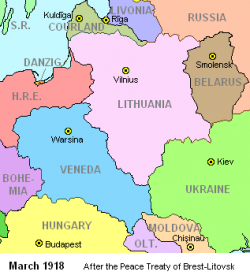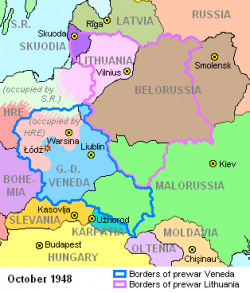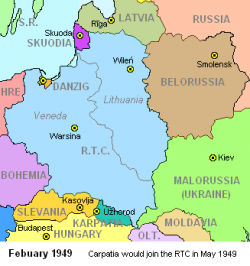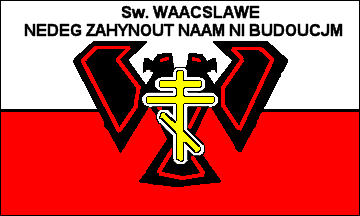Lithuania
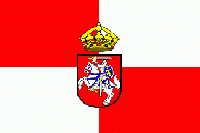
| |
| National motto: ... | |
| Languages | |
| Official | Lithuanian |
| Other | Belarussian, Ukrainian, Yiddish, Sudovian, Wenedyk, Skuodian, Czech |
| Capital | Vilnius (Wileń) |
| Important Cities | Kaunas (Kowień), Klaipėda (Miemł), Šiauliai (Szawle), Panevėžys (Poniewież), Balstogė (Ałbkliw), Gardinas (Grodzień), Lietuvos Brasta (Brześć Litwanik), Lutskas (Łuck), Raunas (Równie) |
| King | King Witold IV Jagiełło (Jogaila) |
| Prime minister | Mindaugas Pustys |
| Area | |
| Population | 9,540,329 (2001) |
| ISO Code | LT |
General information
The Kingdom of Lithuania is one of the two constituents, or crowns, within the Republic of the Two Crowns. It is the eastern half of the country, and much smaller than the other crown, Veneda.
Administration
Government
The Republic of the Two Crowns is a federation of two semi-independent states, Veneda and Lithuania. Both have their own government and parliament, and the institutions of the RTC are mostly a super-structure over those of its two constituents. The parliament of Lithuania consists of 81 members, and is one of the six chambers of the Republic's parliament, the Sejm or Seimas.
Strictly speaking, there is no king of the RTC; instead, there is an elected king of Veneda and an elected king of Lithuania. All three government respond to him: the government of Lithuania in his capacity of king of Lithuania, the government of Veneda in his capacity of king of Veneda, the government of the RTC in both.
Administrative Divisions
Lithuania consists of five provinces (with their capitals): Žemaitija/Samogitia (Kaunas, Kowień), Vilnija/Wilen (Vilnius, Wileń), Palenkė/Suslevia (Gardinas, Grodzień), Polesė/Polesia (Lietuvos Brasta, Brest), and Voluinė/Volhynia (Luckas, Łuck).
Each of the five provinces has their own seimas and leader, referred to as "duke", who is sent to the province by the king, who also carries the title "grand duke" or "grand prince", and is as a medium between him and the the provinces. The autonomy of provinces is, however, limited; and werether Lithuania should be further federalised by letting the dukes to be elected by local people instead of being sent by grand duke and such is an ongoing discution. In each seimas of province, most of memebers are elected directly by names in the valsčiai (sub-units) of the province (one member from each valsčius; cities are partitioned according to population into constituencies and each of them is represented by a member in seimas of province). The rest of members are appointed by the local duke and parliament of Lithuania in equal halves. This is to ensure that the province would not start doing politics against whole state; however, federalists seeks more autonomy for provinces and would preffer if all the seimas of province would be elected by it's people.
In the interwar, Lithuania was partitioned into Apskritys.
Elections and factions
The system of elections is majoritarian, which mean sthat people vote for a person rather than party; due to this, many of the candidates are independents or belonging to small political parties. Once they are elected to seimas of whole grandduchy or of provinces, they tends to form various larger factions in order to represent their opinions better. Two major factions in all the provinces and on the national level are the following:
- Kingdom's Christian Honour (Karalystės krikščioniška garbė, KKG) which tends to be conservative, relatively pro-nobility in political matters but at the same time support social guarantees for poorer classes in economical matters. Members of factions named this way usually opposes any suggestions to reform the traditional system of two countries (Veneda and Lithuania), opposes the possible joining of Voluinė/Volhynia to Galicia, also most other suggestions to alter the political system. These factions are pro-Christianity; Grandduchy Christian Honour in more Catholic provinces tends to be also pro-Catholicism, while in less Catholic regions - more of "Pan-Christian" believes; while in some provincial seimas the Christian idea is less emphasisezed altogether and there are members of the factions who are not Christians there. Factions by the name of Grandduchy National Honour exists in all 5 provinces and in national seimas.
- Modern Lithuania (Modernioji Lietuva, ML), traditional arch-opponent of the Grandduchy Christian Honour factions, is more rightist, supports tax cuts over social guarantees. Theya re usually relctant of supporting nobility however and preffers self-made-men as their ideal. Usually Modern Lithuania factions, commonly reffered to as "the modernists", wants to simplify and democratise political system as much as it is possible, considers fighting corruption and improving economy as major goals. They views teh current political and economic system as outdated. They also agrees on full religious freedom. Factions by the name of Modern Lithuania exists in 3 of the provinces (Palenkė, Vilnija, Polesė) and the national seimas. In the seimai of remaining two provinces, there are similarly named factions which holds similar ideals, named "Modern Samogitia" (Modernioji Žemaitija) and "Modern Volhynia" (Modernioji Voluinė). Factions by this name are larger in richer northern provinces (Žemaitija/Samogitia, Vilnija/Wilno) than in the poorer south, despite that they, in general, aren't as opposed towards more autonomy to smaller nations of the Grandduchy as the Grandduchy Christian Honour faction susually are. This is due to economical policies of the modernist, regarded as pro-rich by poor people.
These two factions are usually the largest and are the only two that exists in semai of all provinces and in the national seimas. There are a number smaller factions, which exists either only in one seimas, or in a few seimai. More notable of those are Lithuanian National Guards (Lietuvių tautos sargai, LTS), which has a bunch of members in seimai of Lithuanian dominated provinces of Žemaitija/Samogitia and Vilnija/Wilno, and a few members in the national seimas (it does not exist in three remaining provinces), usually supports paganism (Romuva), is against any autonomies for other nationalities of the grandduchy, also seeks for the unification of the Lithuania Minor (Lithuanian-speaking areas of the Veneda's Prusy province) with the Grandduchy and often a Lithuanian withdrawal from RTC. Another group of those more notable factions are named the Federalists (Federalistai), also existing in some of Veneda seimas and seeking establishemnt of more autonomies similar to Galicia, including Belarusian, Prussian, Saxon ones and is mostly supported by these nations; Federalists exists in seimai of less ethnic Lithuanian southern provinces (Palenkė/Suslevia, Polesė/Polesia and Voluinė/Volhynia) and also as a small faction in the national seimas. There are some other more notable factions too, and many others, consisting only of few people/parties in a single provincial seimas and changing after every new elections.
Note that people of the same parties might join different factions in different seimas depending on local situation. Also, these factions are not political parties on themselves and does not have any central comitee which would regulate factions with similar names in every province, although similar factions of different seimai tends to keep certain friendly contact. The exact political views of similarly-named factions might differ slightly though in different seimai.
History
The Grandduchy
In the Middle Ages, the largely pagan Grandduchy of Lithuania was one of the largest states in Europe. In 1386, the year of the marriage between grandduke Jogaila and queen Jadwiga, it formed a personal union with the Kingdom of Veneda. In 1569 the Union of Liublin was concluded, and the two merged formally into one state, the Republic of Both Nations.
Lithuania has been part of the Republic during the lion's share of its history. From the 18th century onwards Russia developed an interest in Lithuanian territory too. Large parts of the Grandduchy were swallowed by Russia in the two Partitions of the RBN (1772 and 1793). The subsequent annexation of all the remaining parts of Lithuania in a Third Partition could only be stopped by an alliance with Scandinavia and Bohemia, built by king August IV. At the Congress of Vienna, Napoleon forced Prussia to return much of the territories it had conquered from the RBN, but Russia escaped a similar fate and managed to keep most Belarussian-speaking parts of Lithuania for itself.
In the 19th century, the Venedic nobility maintained much of its power. By the middle of the century, the grandduchy had become the playground of rich Venedic landowners, and the once-proud Lithuanian nation had been reduced to peasanthood. These landowners were particularly hated among the poor populations, and brutal violence was used by the authorities to smash down several peasants' uprisings (1848, 1850, 1860). Another popular uprising in Volhynia in 1863 spread out over large parts of the Republic, and grew into a true revolution. In the heat of the events that followed, the Republic was again invaded by Russia and Prussia in 1866. Parts of Lithuania were incorporated into Russia, but under international pressure the remaining part was granted a high degree of autonomy, and Lithuania de facto became a state within the state.
The name "Republic of Both Nations" has become obsolete by then; most of the time, if was simply referred to as "Veneda".
Independence (1918-1939)
Before the First Great War, Lithuania was to Veneda what a midget was to a giant. The Germans blamed (and punished) only the Veneds for the Republic's acts of war, and they called the Lithuanians "a subjuged minority". In the Treaty of Brest-Litovsk, signed in March 1918, the RBN was effectively split in two parts. Lithuania became an independent state that also included most of Belarus (only the areas around Smolensk and Bryansk remained in Russian hands). Along with Estonia, Livonia, Courland, Ukraine and the Crimea, it became part of a chain of buffer states, all of which (except Lithuania itself) had been taken away from Russia. Veneda became a rump state under a pro-German puppet king. Not only was Lithuania detached from the Republic, it also became a kingdom instead of a grandduchy. King became the German nobleman Wilhelm Herzog von Urach, Graf von Württemberg (1864-1928), "a Catholic, a well educated man, without any close relationship, political ties or intrigues with any German Dynasty." Berlin was not entirely happy with this choice, as Kaiser Wilhelm had preferred to become king of Lithuania himself.
Von Urach was king under the name "Mindaugas II", a reference to the only other king Lithuania had ever had, Mindaugas I (1253-1263). Despite his German background, he was fluent in Lithuanian and felt a genuine desire to become the king of all Lithuanians. After Germany withdrew its hands from the region, Veneda's pro-German king Klemięć II was expelled within a week, but Mindaugas managed to maintain himself.
Lithuania was an artificial and highly unstable state with huge internal differences. While Veneda, apart from a Ukrainian majority in autonomous Galicia, had become an ethnically monolithic state, Lithuania was like the RBN without Veneda as its innovative center. The population consisted of two major nationalities: Lithuanians and Belarussians (along with smaller groups, like notably Ukrainians, but als Veneds, Skuodians and Russians). The top layer were the extremely rich Venedic and Lithuanian landowners, who unanimously endeavoured the restoration of the old Republic. Then, there was a middle class, composed mainly of Lithuanians and Jews; all political orientations were represented here, but most of them favoured a restoration of the Republic as well. The lower class, peasants and workers, consisted of the remaining Lithuanians and almost the entire Slavic majority (most of whom lived in the poorer regions Volhynia and Palesse), and among them extremist tendencies were strong. Predominant among the Belarussians, the largest national group in Lithuania, were: social-democracy (both mensheviks and socialists-revolutionaries), snorism, communism, and Belarussian nationalism. The Belarussians had a particularly strong native snorist movement, not only because Russia appeared to be a better alternative for them than Lithuania, but also because there was a small Belarussian state east of them, centered around Smolensk and Bransk, which was basically a leftover from Great War I left intact by the Russian SNOR regime for propagandistic purposes.
In this constellation, democracy could never become a great success in Lithuania. Since the ruling class consisted mostly of ethnic Lithuanians and Veneds, who were scared to death for whatever the future might bring to them, they did whatever they could to prevent any kind of true democracy from being implemented, as both snorism and socialism/communism would have had serious consequences for them. As far as any general elections were ever held, they were characterised by violence, terror, and falsification. Eventually, democracy was liquidated after a coup in 1926, and Lithuania became a conservative-nationalist dictatorship, led by Antanas Smetona and Augustinas Voldemaras. As a result, during its whole independent existence Lithuania was ruled by Lithuanian nationalists, who were supported (or at least tolerated) by the rich landowners, and maintained the feudal situation on their behalf. Government understood the bad situation it was in and launched a major colonialism project (see Lithuanian colonies) to establish colonies which would help to preserve Lithuanian culture should Lithuania be occupied, and as well serve as a place to send political opponents to. However, this campaign costed much and it's failures were used as propaganda agianst government of Lithuania itself later.
Nevertheless, during the 1930s ethnic tension between the Lithuanian ruling class and the Slavic majority rose to such proportions that it jeopardised the state in its very existence (it was at its height at 1936, during the First Slavic Uprising). Lithuanian nationalism had become discredited because of chronic mismanagement. With a hungry, frustrated bear east of Lithuania, and with snorism as a strong internal and external threat, Lithuania was like a time bomb that could explode any time. Sooner or later, a communist or snorist revolution appeared inevitable, and otherwise a Russian invasion would solve the matter. The Lithuanian regime understood well that it would be unable to prevent such developments without Venedic help, and that the only way to avoid being swallowed by Russia was the restoration of the old Republic.
During the 1930s, restitutio ad integrum by means of a reunification with Lithuania was the main item on the political agenda in Veneda as well. The first active step toward reunification was made in 1937. After the death of king Głorzan, the Venedic Senate elected the Lithuanian king Olgierd (Algirdas) II, as the new king.
Needless to say that both Germany and Russia were not happy with these developments. In a secret treaty, the Lipov-Von Korff Treaty, they divided Eastern Europe into spheres of influence, and before any further steps could be taken towards a restoration of the RBN, Germany invaded Veneda on 1 September 1939 and put an end to its independent existence. Slighly more than two weeks later, on 18 September, Russia invaded Lithuania. This marks the official beginning of the Second Great War. By the end of October, both Veneda and Lithuania were conquered (Lithuania was conquered during the Thunderstorm War).
Under Russian occupation (1939-1943)
In 1943 the Großartige Allianz finally fell apart, and Germany launched a massive attack against Russian-occupied Lithuania, from where it rolled quickly into Belarus and Russia proper. Less than a year later the Baltic states, Lithuania, Belarus, Ukraine, the Crimea, and most of European Russia were occupied by the German-Hungarian armies; the Russian government was forced to leave Moscow and settle itself in Jekaterinograd, in the Ural.
Under German occupation (1943-1947)
Most of the Lithuanian underground formed a common front with the Venedic Armia Pazana, whose head was general Paweł Żaklin; although other Lithuanian and Belarussian groups, mainly communist and snorist partisans, fought their own battle on Lithuanian soil.
Most Lithuanians - both the government-in-exile and those members of the resistance who cooperated with the AP - agreed that the RTC should be restored, as they understood that the only alternative would be Russian hegemony; only the most radical nationalists seemed to prefer a snorist Lithuania over a restored RBN, but since Lithuanian nationalism had been thoroughly discredited because of its mismanagement before the war, their influence was very limited. Thus, when king Olgierd II the Unforgotten, who had chosen to stay in Veneda and lead the resistance instead of escaping the country, was killed in 1940, both governments in exile elected another Lithuanian, Witold III the Absolute, as the new king ad interim. Witold led the Venedic and Lithuanian resitance abroad and underground energetically. He laid the foundation for the factual restoration of the Republic, and thanks to his strong lobby, the RTC was already counted as one of the Allies before it formally existed, despite the fact that it was occupied.
Snorist Lithuania (1947-1949)
This time the Russians followed a different strategy: instead of placing every country under direct military command, they granted them renewed independence, thus assuming the image of liberators. However, this independence was merely a façade: every "liberated" country was immediately provided with a local, snorist or at least pro-snorist puppet government, backed up by Russian troops and taking its orders directly from the government in Moscow. This happened in Lithuania and in Veneda, too (so-called Lithuanian State and Venedic State were established). This government was not recognised by many Lithuanians, however, and the same partisans who had been fighting the German occupant for years now continued their battle with Lithuania's pro-snorist leadership and Russian troops stationed there. The supposedly independent Lithuania of those times controlled only a small part of its former area, with the rest being added to Belarus, Ukraine, Skuodia. The capital Vilnius became Vilnius Free City, a condominium of Lithuania and Belarus. Most of these detached areas were not ethnic Lithuanian, but many ethnic Lithuanian lands were detached as well. In exchange, Russia gave northern Lithuania Minor and some of other lands of Eastern Holy Roman Empire to Lithuania; it portrayed itself as the liberator of those lands, which, according to the official position of government at the time, were for long occupied by the Germans. However, in order to aquire further lands of Lithuania Minor, Lithuania had to fight Germany on the front. The official goal of the Lithuanian State government was to aquire the port of Karaliaučius (Macz Rzegal) as the former Lithuanian port Rūkuvos Uostas was given to Skuodia, and so was the port of Klaipėda; another goal was to take more lands and living space, as according the Act of Return passed by the Russian government in 1947 all people who lived outside the newly carved ethnic state for their ethnicity had to be moved into that state. As many lands were detached from Lithuania, this meant that much more Lithuanans were deported into Lithuania according to the Act (from former Lithuanian areas that were attached to Belarus, Ukraine and Skuodia) than there were people who would be deported from Lithuania. This, coupled with the large ammounts of damaged and destroyed buildings during the war, led to a serious shortage of living space, and it was attempted to compensate the shortage by conwuering German lands. Russia had promised that all historical Lithuania Minor and even Karaliaučius would be left to Lithuania if Lithuania would manage to conquer the areas, and, as many people in the areas were German speaking, according to the Act of Return many would have been deported to the proposed pro-snorist German State, and Lithuanians deported from elsewhere would have been permitted to settle there. It is unclear however if this would have been the case, as there was also a suggestion to create a separate pro-snorist Prussian State in some of the mentioned areas.
It had become clear by now that Russia had its own vision about the future of the countries it liberated, and - partly under pressure of Veneda's government in exile - the other Allies decided to interfere. In November 1948 a meeting was called in Visby, an old Hanseatic city on the isle of Gotland, where all major Allied leaders - of the Scandinavian Realm, the Federated Kingdoms, France, Veneda, and Russia - were present. After long negotiations, Russia somewhat unwillingly accepted the restoration of the RTC, on the condition that it would become a neutral state. The same would go for the Bohemian Kingdom. In return however, a large part of Lithuania - territories were the Belarussian population formed a decisive majority - was added to the Republic of Belarus, and Russia was allowed to keep a presence in the other countries it had occupied: Estonia, Latvia, Slevania, Hungary, the Romanias, the Crimea, Ukraine, and Belarus.
As a direct consequence of Visby, Russia withdrew from Veneda and Lithuania and abandoned both snorist governments. They were quickly overthrown by Venedic and Lithuanian partisans, and the last remnants of German and Russian occupation were cleared away by a popular uprising. By half of December, nothing was left of them. On 4 February 1949, the old Republic was formally restored under the name Republic of the Two Crowns.
The postwar period
The postwar period has been a relatively quiet one for the RTC. It kept its promise to become a neutral state, and acted as a kind of buffer state between Russia and the West. Lithuania's capital Wileń (Vilnius) became a common neutral meeting place for talks between European countries, a position it has preserved until today.
Geography
Lithuania exists on a relatively flat land. Nemunas is its major river, frequently refferd to as "The father of all rivers". Other rivers, such as Narevas and Pripetė, starts in Lithuania.
Borders
North: Skuodia, Latvia. West: Baltic Sea, Veneda. South: Veneda (Galicia) East: Belarus, Ukraine.
Economy
RELEVANT ASPECTS OF THE NATION'S ECONOMICAL SECTOR, EXPORTED PRODUCTS, ETC...
Culture
Languages
The main language is Lithuanian, although bilingualism with Vened language is common. Both Lithuanian and Vened are official. Major minority languages are Belarussian and Ukrainian, spoken in the central Lithuania and southern Lithuania respectively.
Religion
The main religions are (listedby the approximate number of adherents):
- Baltic paganism, formerly followed by the majority of ethnic Lithuanians, now a minority faith rapidly losing ground to atheism.
- Roman Catholicism, followed by most Veneds as well as many Lithuanians, especially those in Palenkė.
- Greek Catholic Church, followed mostly by the Rutuenians, but also by some Venedicized and Lithuanianized Slavs as well.
- Eastern Orthodox Church, the second-largest Christian denomination in the RTC, which has two competing jurisdictions in the country:
- Russian Orthodox Church, followed by most of the country's remaining Russian minority and some Belarussians and Ukrainians.
- Lithuanian Orthodox Church, followed by most Slavic groups in the country as well as a growing number of recent, ethnically-Lithuanian converts.
- Rabbinical, followed by the majority of Jews.
- Karaite Judaism, followed by a minority of Jews as well as by new converts.
- Lutheranism, followed by German communities as well as some Lithuanians from lands formerly belonging to Holy Roman Empire (primarilly Klaipėda)
- Islam, followed by the Lipka Tatars.
- Calvinism, followed by some Lithuanians in northeastern Lithuania.
These seven religious groups are enshrined as traditional religions. In modern times new religious sects were established as well.
National Minorities
Czechs in Lithuania
Czechs started to massively move eastwards to Volhynia on a brake of 19th cc. Tsar Alexandr I. has invited Czech farmers to colonise the territory aquired in partition of Republic of Both Nations, just to dilute the local population and to introduce loyal population. (Russian tsars used later ethnic Czechs to populate some regions in Qazaqstan).
Radicalised society tried to support any anti-Bohemian sentiment and during GW1 their massivelly choose to fight on side of tsarist Russia and later they created feared Czeskaa Bjlaa Legie (Czech White Legion), which had it unsubstitutable role in defeat of bolsheviks. It was silently demilitarised and tried to be forgotten. Legionaarzi (Legionaires) were keen supporters of SNOR in Lithuania and supporters of extreme nationalistic organization Swatowaacslawskaa Orlice (Eagle of St. Wenceslaus), which preached mixture of Orthodox christianity, Czech nationalism and pan-slavism.
During the Second Great War, Legie was re-newed and Legionaarzi were known for their fierce way of fighting and hate for everything German/Bohemian.
Their leader, general Ludwjk Swoboda even lobbied for Russia to take over Bohemia after Veneda and incorporate it into snorist Eastern Europe as Czeskoslowansko (Czechoslavia). He was a president of self-pronounced pro-SNOR government planned in 1948. Fortunatelly, it never came to function. After Congress at Visby, these plans were dead, but Swatowaacslawskaa Legie (Legion of St.Wenceslaus) was hated for their ruthlessness even after war.
Standart of Swatowaacslawska Legie (and proposed pro-SNOR flag of Czechoslawia)
motto: "St. Wenceslaus, do not let die us neither the future ones!"
Czechs in afterwar RTC were silent in the begining, their commitation with SNOR and fighting on a wrong side made an easy target out of them for repressions and examples how to deal with traitors of RTC, although new RTC government was rather liberal. But as situation get calmer, Czechs politians started to grow on local scene and later in 60's their party Swobodnaa Wolinj (Free Volhynia) entered Sejm.
Today live in Volhynia almost half a million Czechs around Luck, Brod and Malin. They are organised in Sokol (Hawk), organisation combining physical excercises, politics and folklore fests, Czeskaa Cesta (Czech Way) - prominent nationalistic party, and Orel (Eagle) - mild successor of Sw. Waacslawskaa Orlice - organisation combining orthodox religion with physical excercises.
Czech are now commited to support Ukrainian rebellion in Galician-Volhynian unification.
Transportation
Transportation is managed on the provincial level in Lithuania, therefore there are disparities between the systems of transportation.
The industrialised Vilnija developed a large railway network. The pre-war railway network was completely rebuilt, the narrow gauge railways were rebuilt into standard gauge and in the 1970s-1980s rapid expansion carried out, that continues up to this day. The railways in Vilnija are well integrated with local metro railroads and subways of major cities. On the main lines the speed of trains is 180-220 km/h. The roads in Vilnija are generally considered to be relatively bad.
Samogitia took a different approach. Until recently it was largely rural province. After the war, several damaged railway lines were not rebuilt. The only new railway line that was built after the Second Great War by the Samogitian authorities was the line Varniai-Klaipėda that connected the rail system of Lithuania to the port of Klaipėda. The partially completed highway system of Samogitia (four-lane and six-lane) will include modern highways with unlimited speed on Kaunas-Klaipėda, Kaunas-Šiauliai, Panevėžys-Šiauliai-Klaipėda routes, as well as Šiauliai-Latvian border and kaunas-Prusy border routes.
Polesė and Voluinė generally relies on railroads for main routes and on roads elsewhere (speed of rail traffic on main railways in these provinces is ~80-120 km/h). In Palenkė railroads are being popularised (some tracks are considered to be high-speed and runs on ~200 km/h, while others on ~120 km/h).
Klaipėda is the only port of Lithuania, but it receives a tough competition from the Venedic ports.
The main airport of Lithuania are in Vilnius, but the Kaunas airport increases its passenger numbers quickly. Lutiškis airport in the south is important as well. International flights (flights to Veneda and Galicia are not considered to be international) are also carried out from Klaipėda, Šiauliai, Gardinas and Lietuvos Brasta.
See also
| |||
|---|---|---|---|
| Countries | |||
| Lithuania | Veneda Galicia (autonomous area) | Venedic West Africa (overseas territory) | |||
| Provinces | |||
| Great Veneda | Hałycz | Karpatia | Kujawia | Leonina | Lesser Veneda | Liublin | Mazowia | Olwarzyn | Polesia | Prussia | Przemarz | Samogitia | Sątakrucz | Silesia | Suślewia | Volhynia | Wilnia |
